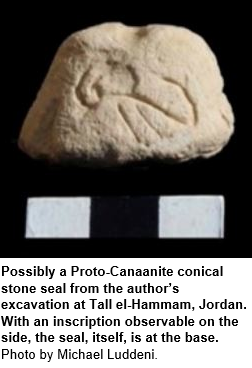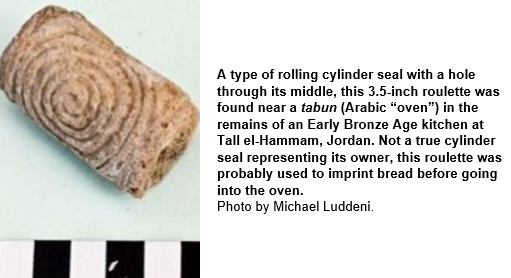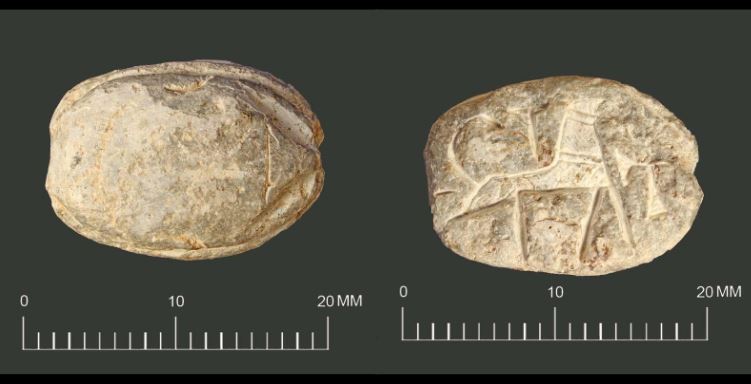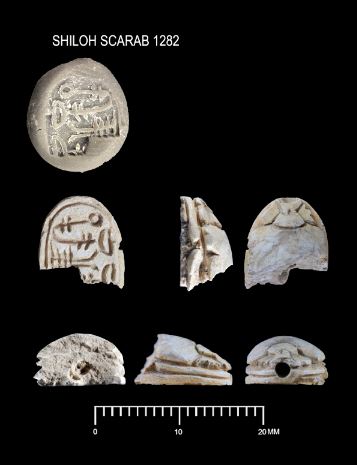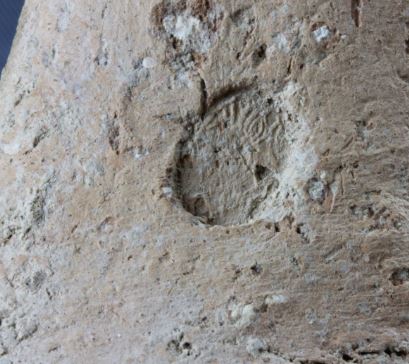In archaeology we find “wonderful things” (to borrow from Howard Carter at the opening of King Tut’s tomb in 1923). Just from my own experience in the field, I have uncovered 17-foot wide city walls still standing 10 feet high, multiroomed city gate complexes and house walls all constructed with mudbrick superstructure on stone foundations, along with doorways and socketstones, cobble or dirt floors, streets and passageways. There’s also been altar stones and tombs, jewelry, weapons, tools, coins, figurines, pottery – complete vessels from large storage jars to “miniature” juglets – and even skeletal remains of the ancients, themselves. Wonderful things, indeed!
Yet, while much less exciting, the most important aspect of archaeological work is the ability to recognize the different levels of ancient occupation. As we dig down, differences in soil consistency, color, texture and contents suggest a lower (and older) layer that also once served as the ground surface where people lived and walked. Our ability to date the time of that layer’s period of occupation is based on the artifacts and features found in it.
The most useful artifacts archaeologists utilize to clarify a layer’s time period is pottery – whether whole or in pieces (sherds). Of course, while much rarer, any kind of inscription found in an occupational layer also becomes a valuable source to date a level. A certain type of inscription – coins – becomes common in later periods of Biblical history (from the 5th century BC onward) and can provide at least an earliest date for an occupational layer (Latin terminus post quem; “boundary after which”).
Ancient Seals
Almost complimentary to coins, another group of small inscriptions were available to help date occupational layers from earlier centuries. As early as the third millennium BC, people of means and influence began carrying them as amulets with the hope that their small specifically engraved image would help bring them safety, protection or prosperity. But by 2000 BC, across the ancient Near East, those images had popularly become seals (signets or stamps) with their imprinted image being transferred to wet clay – as an extension of the owner’s identify, status, influence, ownership and authority. Seals quickly became powerful symbols and tools in Egypt for administrative purposes.
Our English word “seal” is derived from the Latin word sigillum suggesting a “small image,” the perfect description of a seal. But the term also describes what a seal can produce – its own mirror-image stamped into wet clay (sometimes called a “sealing”).
Most ancient seals were carved from small stones with the most common being softer steatite. But harder stones, like carnelian, amethyst and green jasper were also used, along with ivory and horn. In addition, a small number of Egyptian scarab seals were molded from vitrified Egyptian faience. Ancient seals are known with a variety of shapes – knobs, pyramids, cones and cubes – but the most common are cylinder and scarab seals. Most seals have been found pierced to be worn on a necklace or ring.
Mesopotamian Cylinder Seals
In Mesopotamia, seals were typically formed from semiprecious stones (marble, amethyst, lapis lazuli, obsidian) or metal (gold or silver) in the shape of small cylinders (also called “roll seals”) with an inscribed image on the outside and a hole drilled through the center. Typically, only 1-2 inches in length, their mirror-images were rolled out on clay (wax was really not used until after the Biblical period) also typically just 1-2 inches long. A cord of twisted wool or fibers would have passed through its central hole and was likely worn on a necklace. As such, the cylinder seal may have been worn “hidden” beneath a garment or to be seen as an ornament.
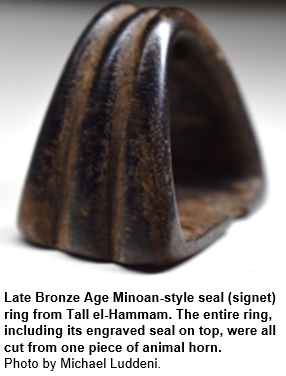
In the account of Judah’s inappropriate interaction with his daughter-in-law, Tamar seems to reference Judah’s own cylinder seal – asking for “your seal, your cord, and the staff that’s in your hand” (Genesis 38:18; see also 38;25). This probably signified his cylinder seal hanging on a cord and his staff (serving as both a tool and weapon). Included with his seal and staff, his “cord” may have been unusually ornate and valuable – like a true necklace.
Egyptian Scarab Seals
During the second millennium BC, ancient Egyptians began carrying tiny (generally less than one inch long) amulets carved in the shape of Egypt’s common black dung beetles (remember the scary black beetles in The Mummy movie?). Scarab is the Latin term for beetle, with kheper the Egyptian hieroglyphic term for the same.
These beetles would lay their eggs in fresh balls of dung and move the balls across the ground to their burrows. When hatched inside these dung balls, the young beetles ate themselves out, suggesting a rather magical event to the Egyptians. Their term for beetles, kheper, translates to something like “coming into being.”
Consequently, ancient Egyptians saw in the beetle’s life cycle a connection to the sun’s daily cycle across the sky. Their sun god, Khepri-Re (depicted as a giant beetle), moved the sun east to west every day. When the sun rose again the next morning, it and Khepri brought light and life to Egypt.
Ultimately, fingernail-sized scarab-shaped amulets became popular and were considered to have great symbolic power for Egyptians during the second millennium. Members of the royal household and administration, along with the wealthy, used these scarabs as their personal seals with images connected to their owners, sometimes even their names or titles.
Called “The Number One Biblical Archaeology Discovery in 2013” by Christianity Today Magazine, this tiny Egyptian stone scarab seal was found at the author’s excavation at Khirbet el-Maqatir, Israel. Picturing a falcon-headed sphinx accompanied by two heliographs, this seal dates to the reign of Pharaoh Amenhotep II (15th century BC). It helped date the destruction of the site to the Late Bronze Age, bolstering the case for Maqatir being Ai – the second city defeated, captured and burned by the Israelites at the beginning of the Conquest of Canaan (Joshua 7-8).
With the top and sides of scarab seals having the appearance of a beetle, the flat bottom was where the seal was engraved. With a hole drilled horizontally from head to tail, Egyptians would have worn these seals on a cord as a necklace or on a ring. As a ring, the beetle top would have generally been displayed with the seal, itself, concealed. To use the seal, the scarab would have been swiveled on the ring to the top and then impressed into clay.
These Egyptian scarab seals also became the most popular form of seals across the eastern Mediterranean world. In some places they carried Egyptian scarabs, but elsewhere producing their own – either in Egyptian or their own local style. While not as common as coins in the later centuries, scarabs are frequently found in excavations across the ancient Near East. At the Associates for Biblical Research sponsored Shiloh Excavations in Israel nine Egyptian scarab seals have been found in contrast to over a thousand coins during the first three sessions.
Dated to Egypt’s Middle Kingdom (13th Dynasty) this stone scarab seal (bottom six views) and modern clay sealing imprint (bulla) top left was found in the author’s excavation at Tel Shiloh, Israel. It dates to the site’s foundational phase (around 1700 BC).
Photo by Michael Luddeni.
Consequently, the significant number of scarabs across the Levant has allowed archaeologists to recognize patterns and assign relative dates to most. Of course, scarabs including a written text (like a Pharaonic cartouche) help clarify dates – even connecting to the absolute dates of a ruler’s reign. In fact, this connection to a ruling Pharaoh kept the Egyptian practice of carrying scarab seals going until the end of the Pharaonic period (first century AD).
During Egypt’s Middle Kingdom, Genesis 41:42 noted the Pharaoh "removing his signet ring from his hand, Pharaoh put it on Joseph's hand.” This Pharaonic signet ring would no doubt have been a scarab seal.
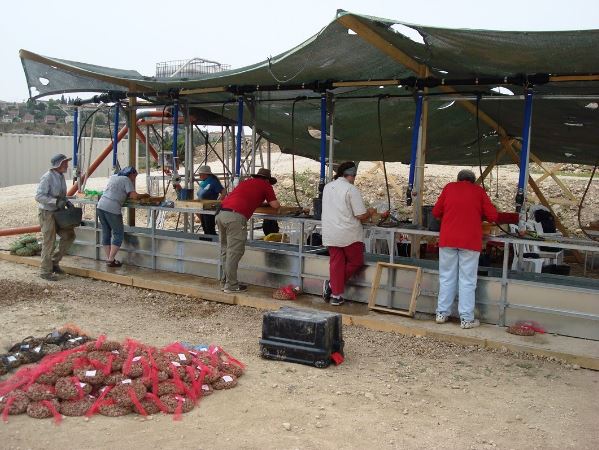
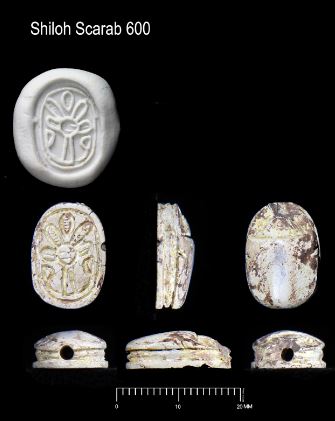
Photo by Michael Luddeni.
Bullae
While a seal (signet or stamp) in the Biblical world was often appreciated as a walk-around-with-you amulet, it also became a symbol of ownership, rank and authority. But, by their very nature, seals were tools used to “seal” a deal by authority of the seal’s owner – generally by impressing the seal into a lump of wet clay on a document to produce the seals’ mirror image in relief.
Interestingly, in English, both the stone device containing the image (seal/signet/stamp) and the mirror-image created in clay (often called a “sealing”) are identified by the same term – “seal.” While the stone seals, themselves, are regularly found in occupation levels from the second and first millennia BC, the much more fragile dried clay sealings are seldom recognized. With the nine stone seals from Shiloh’s first three seasons, we have also found three of these sealings.
The sealings which are known, tend to be in a convex shape because they were regularly used to “close” the exposed outer edge of a papyrus scroll. The dried clump of clay “sealed” the end of the roll to the rest of the document finalizing and securing the deal or message inside.
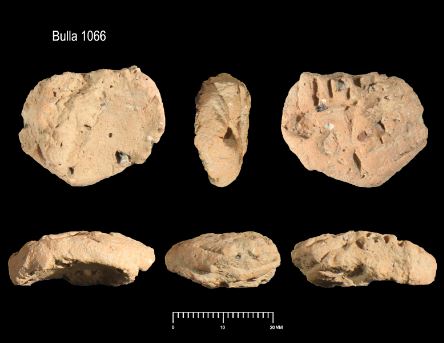
Photo by Michael Luddeni.
In archaeology today, the term used for these sealings is bullae (Latin plural; singular bulla) meaning “bubble,” “round swelling” or “nob” – an appropriate description for the imprinted lump of clay affixed to a smooth papyrus roll. Yet, after 2,000+ years in the dirt, finding the fingernail-sized stone seals is hard enough, let alone the dried clay bullae. When they are found, they can still depict at least part of the seal from which its imprint came. Occasionally even a partial fingerprint of the seal’s user also gets imprinted, providing an amazingly close connection between us and the ancients we are so interested to know better.
Papal Bull
While the true meaning of “Papal Bull” could easily be misunderstood today, the phrase has a long history – referring to a document issued by the Vatican containing the highest authoritative edict issued by, or in the name of, the pope. In use for centuries, the term apparently comes from our same Latin term bulla (“bubble” or “round swelling;” plural bullae). Early papal bulls were issued on papyrus or parchment scrolls, long before the printing press. The imprint of the pope’s seal on a wax bulla was the ultimate symbol of his authority. By the 12th century AD the sealing, itself, became a two-sided lead (gold for special occasions) disk which was impressed with the pope’s seal while the metal was still hot.
So, to finally tie this article about ancient seals to its title (The Pope, Beetles and Bullae). The Pope’s connection to beetles (scarab seals) comes by way of the bulla – which both the Pope and scarab seals produce.
Not technically a bulla, this scarab seal impression in this enlarged photo is at the upper end of the top side of a Middle Bronze Age storage jar handle from the Shiloh Excavations, Israel. The seal was impressed into the wet clay before the jar was fired in a kiln. To the sides of the impression can be seen fingerprints of the one who imprinted the seal.
Photo by Michael Luddeni.
Final Thoughts
Our English term ”seal” is used to describe both the implement with an engraved image and the mirror-image of its engraving that can be impressed onto another medium. The English word comes from the Latin term sigillum – with sigillography being the study of seals – both the implement which makes the impression, as well as the resultant mirror-image impression. The Greek term for seal is sphragis and sphragistics is synonymous term with sigillography for the study of seals. No surprise, sphragis is the Greek word in the New Testament for either the impression-making apparatus or its resultant mirror-image. Its Old Testament Hebrew counterpart, chatham has same meaning.
So, when we read about God’s seal on someone, it means God has marked them with His special mark, signifying His identity with and ownership of them as well as their authority to represent Him to others.
Addendum: Collection of Old and New Testament verses referencing seals
Job 38:14 …the earth takes shape like clay under a seal
High Priestly accoutrements engraved like a seal
Exodus 28:11 on the ephod, two onyx stones engrave the way a gem cutter engraves a seal with the names of the 12 sons
Exodus 28:36 on the breastplate of the ephod twelve stones engraved like a seal with the names of the twelve sons of Israel (also 39:14)
Exodus 39:30 on the plate of the turban, the sacred emblem was engraved out of pure gold, like an inscription on a seal
Written documents sealed with authorization, authority and responsibility
I Kings 21:8 – Jezebel wrote and sealed letters with King Ahab’s seal
Nehemiah 9:38; 10:1 – agreement sealed with the seals of the Israelite leaders, Levites and priests
Esther 3:12; 8:8, 10 – documents sealed by the ring of King Xerxes
Jeremiah 32:10, 11, 14, 44 – land deeds sealed as authorized finalized documents
Revelation 5:1, 5 – the seven-sealed scroll in the right hand of the one on the throne in Heaven
Revelation 5:5; 6:1 ,5, 7, 9 – Jesus, as the Lion of the Tribe of Judah and the Root of David, was worthy to and did open the seven seals of the sealed scroll
Written documents sealed to conceal a message by God’s authority
Isaiah 8:16; 29:10-11 – twice God told Isaiah that his message was to be as a sealed scroll for that time and place by God’s own authority
Daniel 8:26; 9:24; 12:4, 9 – four times God told Daniel that his vision was to be as a sealed scroll for that time and place by God’s own authority
Written document not sealed in order to reveal God’s message
Revelation 22:10 – John was told to not seal up the words of his scroll because the time was near
Stone sealed to block an entrance
Daniel 6:17 – Daniel in the lion’s den was sealed by King Nebuchadnezzar’s ring
Matthew 27:66 – Jesus’ tomb sealed by Roman authorities
God’s seal on…
Jeremiah 22:24 – to Jeconiah (Jehoiachin) king of Judah the LORD said even though you were the seal on my right hand I would pull you off (a scary thought!)
John 6:27 – the Son of Man has God the Father’s seal of approval
2 Corinthians 1:22 – God’s seal of ownership is on us and His Spirit is in our hearts as a deposit, guaranteeing what is to come
Ephesians 1:13 – God’s people are marked with His seal, the promised Holy Spirit
Ephesians 4:30 – God’s people are not to grieve the Holy Spirit by whom we were sealed for the day of redemption
2 Timothy 2:19 – God’s solid foundation stands firm, sealed with this inscription: “The Lord knows those who are his,” and, “Everyone who confesses the name of the Lord must turn away from wickedness.”
Revelation 7:2, 3, 4 – an angel coming up from the east having the seal of the living God…put a seal on the foreheads of the servants of the living God…144,000 from all the tribes of Israel







